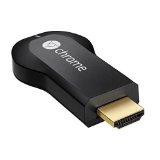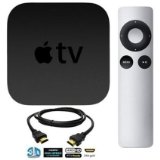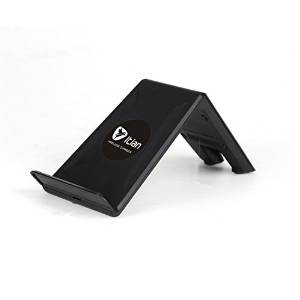Catching Up With Not-So-New Tech Gear
By Wayne Maruna
(Feruary. - March, 2015)
The
annual Consumer Electronics Show made its usual January appearance in
Las Vegas, with all the requisite 'oohs' and 'aahs'. I was not
there. I’m still picking through the cool gadgets from about two
years back.
People may think of me as a tech guy, which is
probably true, but what I am not is a tech pioneer. At work we
used to say that the pioneers were the ones with the arrows in their
hats. Our strategy at the time was to be a ‘fast follower’.
Well, I’m more of a slow follower, but if a technology proves to be
enduring, I will eventually catch up to it and embrace it. With
that in mind, for the benefit of the really slow followers, I bring you
four of my most recent and heartily endorsed tech toys.
Google Chromecast
 The
Chromecast device looks like a fat USB flash drive ready to
spawn. But instead of plugging into a USB port, it plugs into an
HDMI port on the back of a TV (most modern LCD TVs have at least one
HDMI - High Definition Multimedia Interface - port.) The device
requires power, which it can get from the TV’s USB port via a supplied
cable, or, if the TV lacks a USB port, from a Google-supplied wall plug
that the USB cable connects to, much like a charging cell phone.
The
Chromecast device looks like a fat USB flash drive ready to
spawn. But instead of plugging into a USB port, it plugs into an
HDMI port on the back of a TV (most modern LCD TVs have at least one
HDMI - High Definition Multimedia Interface - port.) The device
requires power, which it can get from the TV’s USB port via a supplied
cable, or, if the TV lacks a USB port, from a Google-supplied wall plug
that the USB cable connects to, much like a charging cell phone.
The
Chromecast is designed to work with your computer or laptop or mobile
device. You use the Chromecast software to make your wireless
connection, then call up an app on your PC or mobile device, and ‘cast’
the output onto your TV. I’ve been able to show photos from my
cell phone onto a TV with this little device. You can carry it in
your pocket if you are traveling to someone else’s location, plug it
into their TV and log in with their wireless connection, and you can
‘cast’ content from a PC, laptop, tablet, or smart phone which has the
freely available Chromecast software. This would be one way to
add Netflix to a TV that lacks input by other means. MSRP is a
cheap $35; I got mine for $25 during Staples’ Thanksgiving weekend
madness. One caveat: not all routers will work with the device.
Check Google’s Chromecast router compatibility list first.
Apple TV
 The
Apple TV isn’t actually a TV. It is a device that measures about
4 inches square and an inch high. It sits near your TV and
connects to your router either via Ethernet cable if available, or
otherwise wirelessly. It provides a portal to various web services like
Netflix, Hulu Plus, and content stored on the web by the likes of CBS,
CNBC, ABC, Fox, Showtime, HBO, the NBA, and others. You can connect
over your network to your iTunes app on your computer and stream any of
your content to your entertainment system. You can also connect
to your Apple mobile device (iPhone, iPad) and use what Apple calls Air
Play to stream from the device to your TV. I’ve used it to show
vacation photos, stored on the web, onto the big screen to a group of
captive guests, using my iPad for navigation. The device comes
with a tiny remote that is half the size of a tongue depressor stick
and with just three buttons; a simpler design you will not find.
The Apple TV is priced at about $99.
The
Apple TV isn’t actually a TV. It is a device that measures about
4 inches square and an inch high. It sits near your TV and
connects to your router either via Ethernet cable if available, or
otherwise wirelessly. It provides a portal to various web services like
Netflix, Hulu Plus, and content stored on the web by the likes of CBS,
CNBC, ABC, Fox, Showtime, HBO, the NBA, and others. You can connect
over your network to your iTunes app on your computer and stream any of
your content to your entertainment system. You can also connect
to your Apple mobile device (iPhone, iPad) and use what Apple calls Air
Play to stream from the device to your TV. I’ve used it to show
vacation photos, stored on the web, onto the big screen to a group of
captive guests, using my iPad for navigation. The device comes
with a tiny remote that is half the size of a tongue depressor stick
and with just three buttons; a simpler design you will not find.
The Apple TV is priced at about $99.
Charging Pads
 When
I acquired my Samsung Galaxy S5 smart phone, I quickly grew tired of
attaching its charging cable. I admit to being a nail biter,
which made opening the tiny little micro-USB port cover on the bottom
of the phone difficult. Additionally, the cable connection was a
real hassle for me to plug in. There’s got to be a better way, I
thought, or this was going to be a long two years of contract
commitment. And there was. This required a 2-part
solution. The first part is a wireless charging receiver, called
a Qi coil, about the size of a credit card and half as thick.
This gets inserted into the back of your phone, held in place by the
reattached cover. Some people feel this causes a bulge in the
back of the phone, but I did not see one, and believe me, I know
bulges. The second part is a charging mat or, in my case, stand.
The stand is about as tall as the cell phone and plugs into a wall
outlet. Now when I come home, I simply place the phone on the
charging stand, and the phone beeps and displays a message that it is
wirelessly charging. It all seems like magic, and I get a tiny
thrill to see technology actually working like it is supposed to. The
Qi coil cost all of $10. The chargers vary in price from $10 to $60.
When
I acquired my Samsung Galaxy S5 smart phone, I quickly grew tired of
attaching its charging cable. I admit to being a nail biter,
which made opening the tiny little micro-USB port cover on the bottom
of the phone difficult. Additionally, the cable connection was a
real hassle for me to plug in. There’s got to be a better way, I
thought, or this was going to be a long two years of contract
commitment. And there was. This required a 2-part
solution. The first part is a wireless charging receiver, called
a Qi coil, about the size of a credit card and half as thick.
This gets inserted into the back of your phone, held in place by the
reattached cover. Some people feel this causes a bulge in the
back of the phone, but I did not see one, and believe me, I know
bulges. The second part is a charging mat or, in my case, stand.
The stand is about as tall as the cell phone and plugs into a wall
outlet. Now when I come home, I simply place the phone on the
charging stand, and the phone beeps and displays a message that it is
wirelessly charging. It all seems like magic, and I get a tiny
thrill to see technology actually working like it is supposed to. The
Qi coil cost all of $10. The chargers vary in price from $10 to $60.
Ubiquiti Unifi Access Point
 Wireless
access is almost a necessity in the modern home. Yet obtaining an
adequate wireless signal in the farthest reaches of your home can be a
problem. Alternatives may include powerline networking devices or
wireless extenders. Well, you can add the Ubiquiti Unifi AP and
AP-LR to the list of solutions. These are wireless access points
on steroids, especially the LR (Long Range) model. The product
itself looks like a Frisbee and does require a wired Ethernet
connection for its starting point, plus the installation software can
be daunting for people unfamiliar with wireless networking terms.
But for someone who knows what their current SSID (network name) and
password is, it can actually be pretty simple. And it will
seriously cure the wireless connection problems in even the largest
homes this side of LeBron James’s 35K sq. ft. house. Read more
here: http://www.ubnt.com/unifi/unifi-ap/. These are commercial
grade devices at consumer prices ($68 to $90).
Wireless
access is almost a necessity in the modern home. Yet obtaining an
adequate wireless signal in the farthest reaches of your home can be a
problem. Alternatives may include powerline networking devices or
wireless extenders. Well, you can add the Ubiquiti Unifi AP and
AP-LR to the list of solutions. These are wireless access points
on steroids, especially the LR (Long Range) model. The product
itself looks like a Frisbee and does require a wired Ethernet
connection for its starting point, plus the installation software can
be daunting for people unfamiliar with wireless networking terms.
But for someone who knows what their current SSID (network name) and
password is, it can actually be pretty simple. And it will
seriously cure the wireless connection problems in even the largest
homes this side of LeBron James’s 35K sq. ft. house. Read more
here: http://www.ubnt.com/unifi/unifi-ap/. These are commercial
grade devices at consumer prices ($68 to $90).
 The
Chromecast device looks like a fat USB flash drive ready to
spawn. But instead of plugging into a USB port, it plugs into an
HDMI port on the back of a TV (most modern LCD TVs have at least one
HDMI - High Definition Multimedia Interface - port.) The device
requires power, which it can get from the TV’s USB port via a supplied
cable, or, if the TV lacks a USB port, from a Google-supplied wall plug
that the USB cable connects to, much like a charging cell phone.
The
Chromecast device looks like a fat USB flash drive ready to
spawn. But instead of plugging into a USB port, it plugs into an
HDMI port on the back of a TV (most modern LCD TVs have at least one
HDMI - High Definition Multimedia Interface - port.) The device
requires power, which it can get from the TV’s USB port via a supplied
cable, or, if the TV lacks a USB port, from a Google-supplied wall plug
that the USB cable connects to, much like a charging cell phone. The
Apple TV isn’t actually a TV. It is a device that measures about
4 inches square and an inch high. It sits near your TV and
connects to your router either via Ethernet cable if available, or
otherwise wirelessly. It provides a portal to various web services like
Netflix, Hulu Plus, and content stored on the web by the likes of CBS,
CNBC, ABC, Fox, Showtime, HBO, the NBA, and others. You can connect
over your network to your iTunes app on your computer and stream any of
your content to your entertainment system. You can also connect
to your Apple mobile device (iPhone, iPad) and use what Apple calls Air
Play to stream from the device to your TV. I’ve used it to show
vacation photos, stored on the web, onto the big screen to a group of
captive guests, using my iPad for navigation. The device comes
with a tiny remote that is half the size of a tongue depressor stick
and with just three buttons; a simpler design you will not find.
The Apple TV is priced at about $99.
The
Apple TV isn’t actually a TV. It is a device that measures about
4 inches square and an inch high. It sits near your TV and
connects to your router either via Ethernet cable if available, or
otherwise wirelessly. It provides a portal to various web services like
Netflix, Hulu Plus, and content stored on the web by the likes of CBS,
CNBC, ABC, Fox, Showtime, HBO, the NBA, and others. You can connect
over your network to your iTunes app on your computer and stream any of
your content to your entertainment system. You can also connect
to your Apple mobile device (iPhone, iPad) and use what Apple calls Air
Play to stream from the device to your TV. I’ve used it to show
vacation photos, stored on the web, onto the big screen to a group of
captive guests, using my iPad for navigation. The device comes
with a tiny remote that is half the size of a tongue depressor stick
and with just three buttons; a simpler design you will not find.
The Apple TV is priced at about $99.  When
I acquired my Samsung Galaxy S5 smart phone, I quickly grew tired of
attaching its charging cable. I admit to being a nail biter,
which made opening the tiny little micro-USB port cover on the bottom
of the phone difficult. Additionally, the cable connection was a
real hassle for me to plug in. There’s got to be a better way, I
thought, or this was going to be a long two years of contract
commitment. And there was. This required a 2-part
solution. The first part is a wireless charging receiver, called
a Qi coil, about the size of a credit card and half as thick.
This gets inserted into the back of your phone, held in place by the
reattached cover. Some people feel this causes a bulge in the
back of the phone, but I did not see one, and believe me, I know
bulges. The second part is a charging mat or, in my case, stand.
The stand is about as tall as the cell phone and plugs into a wall
outlet. Now when I come home, I simply place the phone on the
charging stand, and the phone beeps and displays a message that it is
wirelessly charging. It all seems like magic, and I get a tiny
thrill to see technology actually working like it is supposed to. The
Qi coil cost all of $10. The chargers vary in price from $10 to $60.
When
I acquired my Samsung Galaxy S5 smart phone, I quickly grew tired of
attaching its charging cable. I admit to being a nail biter,
which made opening the tiny little micro-USB port cover on the bottom
of the phone difficult. Additionally, the cable connection was a
real hassle for me to plug in. There’s got to be a better way, I
thought, or this was going to be a long two years of contract
commitment. And there was. This required a 2-part
solution. The first part is a wireless charging receiver, called
a Qi coil, about the size of a credit card and half as thick.
This gets inserted into the back of your phone, held in place by the
reattached cover. Some people feel this causes a bulge in the
back of the phone, but I did not see one, and believe me, I know
bulges. The second part is a charging mat or, in my case, stand.
The stand is about as tall as the cell phone and plugs into a wall
outlet. Now when I come home, I simply place the phone on the
charging stand, and the phone beeps and displays a message that it is
wirelessly charging. It all seems like magic, and I get a tiny
thrill to see technology actually working like it is supposed to. The
Qi coil cost all of $10. The chargers vary in price from $10 to $60. Wireless
access is almost a necessity in the modern home. Yet obtaining an
adequate wireless signal in the farthest reaches of your home can be a
problem. Alternatives may include powerline networking devices or
wireless extenders. Well, you can add the Ubiquiti Unifi AP and
AP-LR to the list of solutions. These are wireless access points
on steroids, especially the LR (Long Range) model. The product
itself looks like a Frisbee and does require a wired Ethernet
connection for its starting point, plus the installation software can
be daunting for people unfamiliar with wireless networking terms.
But for someone who knows what their current SSID (network name) and
password is, it can actually be pretty simple. And it will
seriously cure the wireless connection problems in even the largest
homes this side of LeBron James’s 35K sq. ft. house. Read more
here: http://www.ubnt.com/unifi/unifi-ap/. These are commercial
grade devices at consumer prices ($68 to $90).
Wireless
access is almost a necessity in the modern home. Yet obtaining an
adequate wireless signal in the farthest reaches of your home can be a
problem. Alternatives may include powerline networking devices or
wireless extenders. Well, you can add the Ubiquiti Unifi AP and
AP-LR to the list of solutions. These are wireless access points
on steroids, especially the LR (Long Range) model. The product
itself looks like a Frisbee and does require a wired Ethernet
connection for its starting point, plus the installation software can
be daunting for people unfamiliar with wireless networking terms.
But for someone who knows what their current SSID (network name) and
password is, it can actually be pretty simple. And it will
seriously cure the wireless connection problems in even the largest
homes this side of LeBron James’s 35K sq. ft. house. Read more
here: http://www.ubnt.com/unifi/unifi-ap/. These are commercial
grade devices at consumer prices ($68 to $90).